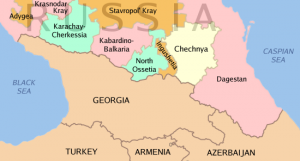The Russian-Chechen conflict: Factors that triggered the conflict to become an armed conflict in 1994-1996 and then again in 1999 (Part II)
Category: chechnya, guests, russia
Tags: anders t. carlsson, chechnya, Michael E. Brown, russia, Russian-Chechen conflict
We continue today with Part II of Anders T Carlsson’s essay “The Russian-Chechen conflict: Factors that triggered the conflict to become an armed conflict in 1994-1996 and then again in 1999”. Don’t forget to read Part I.
Political Factors that triggered the conflict to war
Political transitions is a triggering cause in the Russian-Chechen conflict. The Chechen decision to declare independence was taken by Dzhokhar Dudayev after being elected president in 1991. The Russian state had no intention to recognize this unilateral declaration. These two positions constitute the conflict over the Chechen territory.
The decision to start war in Chechnya in 1994 was taken by the Russian president Boris Yeltsin. In 1999 it was taken by the prime minister Vladimir Putin. These historic facts support the theory that political decisions most often are the proximate (triggering) causes for war. It is also important to state that the decisions by the leaders were taken due to underlying political (the urge to stay in power), economic and military-strategic factors.
From the Chechen declaration of independence in 1991 Dzhokhar Dudayev and Boris Yeltsin had a long and hostile arguing, both attacking and insulting each other. This increased the hostile situation. The personal antagonism and inability to raise above this is in my sources said to be the reason for why the conflict could not be solved by negotiations like it had been done in Tatarstan and Bashkortostan.
In 1994 the ultra nationalist leader Zjirinovskij´s party had won 25% of the seats in the Duma – the Russian parliament. Yeltsin is said to have had ideas of a ”short successful war” to improve his popularity among the nationalists to be able to secure his power in the next presidential election. Intensifying leadership struggles is an important triggering cause explaining why the invasion of Chechnya was launched in December 1994. By the time for the campaign for the 1996 presidential elections the war was a heavy weight on the shoulders of president Yeltsin who gave order to negotiate a ceasefire. As a result the Russian troops left Chechnya but it was only a tactical and temporary withdrawal.

View of a gorge in the Caucasus Mountains in Chechnya.
Early color photograph from Russia, created by Sergei Mikhailovich Prokudin-Gorskii as part of his work to document the Russian Empire from 1909 to 1915.
Photo from wiki.
During the summer of 1999 Chechen fighters went into Dagestan proclaiming to fight for the establishment of a joint Muslim state in Northern Caucasus. As a response Yeltsin fired the Russian prime minister Sergej Stepasjin and replaced him with the head of the internal security forces (FSB) Vladimir Putin. Putin declared that Chechnya was going to be subdued with violence and launched a new military offensive. This second war was supported by controlled reports in Russian national media and made Putin widely popular within Russia. When Yeltsin declared his resignation at New Years Eve 1999 he appointed Putin as his successor. This shows how political transitions and agendas has significant influence on conflicts.
In March 2003 a criticized election on a new Chechen constitution took place and in October the by Putin proposed candidate Ahmed Kadyrov was elected president. From this on Moscow have appointed new president candidates when the former have been killed. The present Chechen president Ramzan Kadyrov, that was elected in what has been called a charade election in 2007 has set up a strong militia “the Kadyrovtsy” to wipe out all sessessionists and revenge the killing of his father – who was assassinated.while being president of Chechnya. Ramzan Kadyrov is the head of the pro-Putin United Russia party that rules Chechnya today. The rule of Kadyrov has made the eliminating of the “separatists” a local pro Russian Chechen issue. Human Right Organisations condemns the methods used by the Kadyrovtsy. In April 2009 it was announced from Kreml that the military operation was ended as a result of the improved situation in Chechnya. This has also lead to growing inter-group competition and violence.
Ultra nationalistic and fascistic movements has grew to such extent in Russia that it is regarded as dangerous for people with ethnic background in the Caucasus or Central Asia to live in Russia. They are targets for violence, extortion and some times even murder. The prevailing racism in Russia is part of an influential exclusionary nationalistic ideology that is also used by Vladimir Putin for his own purposes. The racist perception of Chechen and other Caucasian people makes it possible to wage extreme violence and war on these populations. This shows that increasingly influential exclusionary ideologies is part of the explanation what makes internal war possible.
Economic and social factors that triggered the conflict to war
Before the wars Chechnya was a transit country for oil and gas pipelines from the oil rich Caspian Sea region to the Black Sea Cost. It was also a country with own but fading oil reserves. It was of economic and strategic significance for Russia to control the area mostly for the sake of the pipelines.
As a result of the first war the infrastructure in Chechnya was destroyed and due to the isolation from the world and the Russian politics the infrastructure was not rebuilt. It was extremely hard to make an income and as a result violence and criminal actions like kidnappings and theft increased and spilled over into neighbouring states. This further isolated Chechnya and made the situation even worse. These mounting economic problems is also an explanation of what triggered the war.

Map of Chechnya. From wiki.
Conceptual and perceptual factors that triggered the conflict to war
The racist perception of Chechen and other Caucasian people that many Russians holds make it possible to wage extreme violence and war on populations like the Chechen. The intensifying patterns of cultural discrimination from the beginning of the 1990´s is also a triggering cause that makes the wars possible and accepted within Russia.
A series of bombings of civilian houses in Moscow and other Russian cities in September 1999 were said to be the deeds of Chechen terrorists and gave Putin a broad support for starting his military offensive in 1999. There are accusations that FSB were indeed responsible. However, the bombings was used to explain why the war in Chechnya was necessary. This is just one example of how ethnic bashing and propaganda are used for the purpose of gathering support for why conflicts should be solved by military means. The politically initiated propaganda in support of the war is made possible and has a strong impact because the media in Russia is controlled by the state. The state controlled TV-channels are the main source of information for the vast majority in present day Russia. The state controlled media are regarded as tools for the ruling group to maintain power.
Conclusion of he triggering causes of two wars between Russia and Chechnya
As shown in the text the Russian-Chechen conflict escalated into war as the result of decisions taken by the leaders of the Russian state and the leader of the territory of Chechnya that wanted to break free from Russia. The reason that the conflict was not solved peacefully was elite driven and internal (Chechnya was a part of Russia that wanted to break free.)
It is important to state that the decisions taken by the leaders were due to underlying political (the urge to stay in power), economical and military-strategic factors. The historical background with a persistent resistance and almost permanent warfare from 1783 to 1943 and the following deportation of the Chechen population has created experiences and memories that forms the notion of the other as a permanent enemy. The Russian hard-core decision to dominate the Caucasian territory and the Chechen hard-core resistance to this is the reason why the conflict started and has continued. War might maybe have been avoided like in Tatarstan and Bashkortostan if Boris Yeltsin and Dzhokhar Dudayev had not been driven also by personal antagonism.
This text is also a result of a dialogue with David Johansson in the process of writing.
Sources
BBC profile: Chechnya
BBC article Chechnya making regional waves, 17 January, 2000
Michael E. Brown, The Causes and regional Dimension of Internal Conflict, in Michael E. Brown, (ed.) The International dimension of Internal Conflict, London, 1996.
Svante E. Cornell, Russia’s war with Chechnya, in Svane E. Cornell’s Small Nations and Great Powers. A Study of Etnopolitical Conflict in the Caucasus, Avon, 2001.
Åsne Seierstad, Ängeln i Grozny, Smedjebacken, 2008.
Ebba Sävborg, Tjetjenien – krig i tvåhundra år, in Världspolitikens dagsfrågor, No 2, Stockholm 2003.


